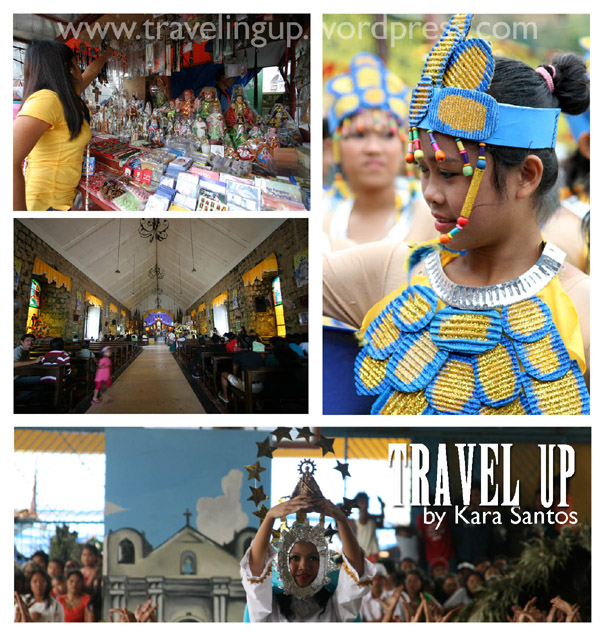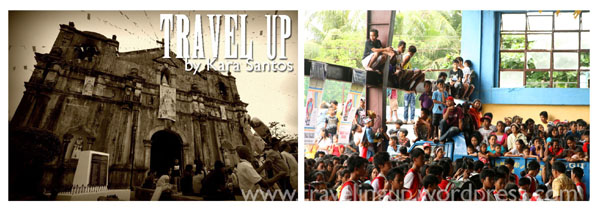You have to admire the creativity of Pinoys when it comes to fiestas. Imagine coming up with unique costumes, dances and props centered around a certain theme every year. Multiply that by the number of groups competing in street dances that have become a staple of any fiesta.
This was one thought that crossed my mind when we visited Camarines Norte earlier this year during the launch of the Quadricentennial celebration of the first three parishes of the Diocese of Daet: namely Nuestra Senora de Candelaria in Paracale (Feb 2), St. John the Baptist Church in Daet (June 24) and St. Peter the Apostle Parish in Vinzons (June 29).
From Bagasbas Lighthouse in Daet, we made our way to the municipality of Paracale by van. When we got there, we had to park down the street as the main road was closed for festivities, so we made our way on foot to the Spanish-era Paracale Church.
The 400-year anniversary celebration in Paracale coincided with their annual “Pabirik” festival (the process of panning gold) celebrating the town’s gold mining industry. Like most rural fiestas, locals celebrated with truly Pinoy flair. Small streets outside the church were lined with numerous food stalls and bazaars where vendors hawked everything from ukay-ukay, jewelry made out of old coins, to live birds that children would pull around on a string. Meanwhile, students participating in the parade walked around in an assortment of glittery costumes depicting gold miners, fishermen and religious figures.
While it had been rainy during most of our three-day visit, the weather eased up a little during the fiesta allowing us to take a few shots of the church and street (or rather “gym”) dances.
As expected, the area surrounding the church was crowded with vendors (as well as food wrappers and the like) and the sky was still overcast so it wasn’t really ideal for taking photos of the facade. Though the covered court was jam-packed with people watching the dances, we were ushered in by our escorts, provincial tourism officer Amable Miranda and tourism photographer Raffy de Vera to the front stage with the judges, where we got a pretty good view. Aside from elaborate paintings of the church and large cardboard cutouts of boats carried by dancers as background props, some groups made use of karitons covered in cloth to wheel in dancers dressed as statues of religious icons and angels (who did their best to maintain their balance). An elaborate dance routine that drew the most applause from the crowd had dancers flinging strips of fabric in the air.
The existence of gold mines in the region is said to be the main reason why Spaniards colonized and Christianized the area. The Paracale church was founded by Fransiscan missionaries in 1581 and assigned a minister in 1611. Interestingly, locals still pan for gold in Paracale (also known as “Gold Town”), which is one of the major industries aside from agriculture and fishing. According to tourism information, among 27 barangays in this municipality, there are 22 barangays where gold is found in forms of either sand, nuggets or gold ores. However, others fear (and with good reason) that the gold will eventually run out.




hi! I’m currently doing a research on ethnomusicology in the Philippines. I read the articles here and they are very interesting. I would like to seek your help if you happen to be in a place where the original music of the people are still practiced such as children’s folk games/chants, singing during harvest, courting through singing, discussion through chants or singing, etc. just music that is unique to their place.
Thank you and hope to hear from you soon! ♪
Hi Cess. I’m based in Manila, so I’m not sure how I can help you with your research. Here are the following posts where I encountered interesting folk games/songs and chants during my travels:
– Matigsalogs: http://www.traveling-up.com/finding-bliss-in-a-tribal-fiesta/
– Aeta Folk Games: http://www.traveling-up.com/aeta-youth-festival-in-tarlac/
– Aeta rituals, songs and dances: http://www.traveling-up.com/first-aeta-forest-food-festival/
I can probably hook you up with NGOs that work directly with the communities. If you need more help, please email me at kara.m.santos@gmail.com